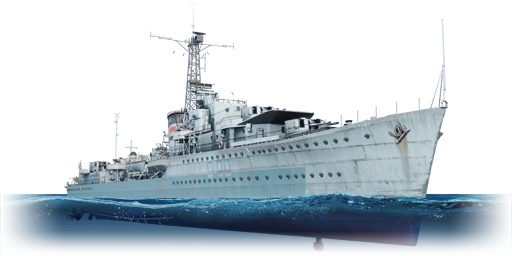The HMS Jervis was a J-class destroyer named after Admiral John Jervis. Jervis was laid down on 26th August 1937 and commissioned on 8th May 1939. Unlike other J-class destroyers, Jervis' role was to serve as a flotilla leader for the J-class destroyers forming the 7th Destroyer Flotilla. She was identical to K-class destroyer leader Kelly and N-class destroyer leader Napier. On the second day after war broke out, September 2nd 1939, Jervis managed to capture a blockade runner and two more until the end of 1939. She continued to serve in Home Waters until 1940 when she was sent to the Mediterranean where she served until late 1943. In 1941, she took part in the Battle of Cape Matapan where she torpedoed and sank Italian heavy cruiser Zara with three torpedoes that hit her magazines and caused a fatal explosion. After that, a boarding party from Jervis captured the crippled heavy cruiser Pola, took off the wounded and let HMS Nubian torpedo and sink the heavily damaged ship. She also participated in the Battle of Crete and the First Battle of Sirte. On her way back to Alexandria, she was badly damaged by an Italian human torpedo attack and had to undergo a six-week-long repair. During 1942, Jervis took part in the Second Battle of Sirte. She also supported Allied landings on Sicily, Anzio, and other places in the Mediterranean. She was decommissioned in September 1944 after taking part in the Normandy landings, but was recommissioned in May 1945 and served in the Mediterranean again until May 1946 when she was placed in reserve. She was sold for scrap in 1949. Jervis was awarded 13 battle honours for her service, two other ships that also served with Jervis matched that number, namely HMS Orion and HMS Nubian, with a single ship exceeding it: the flagship of the Mediterranean fleet, HMS Warspite, with 15 to her name.
HMS Jervis was introduced in Update "New Power". Her armament consists of three twin 120 mm Mk. XII turrets on CPXIX mounts with 12 rounds per minute utilizing first-stage ammunition; once that is depleted, the rate of fire drops to still very impressive 10 rounds per minute. Her anti-aircraft weaponry consists of a single quadruple 40 mm QF Mk.IIc autocannon, four twin 20 mm Oerlikon Mk.V autocannons, and two single 20 mm Oerlikon Mk.II autocannons. She is also armed with quintuple and quadruple Mk. IX torpedo launchers with 533 mm Mk. IX torpedoes with a base range of 10 km, above-average speed of 76 km/h and one of the heaviest payloads of 587.2 kg TNT equivalent. Jervis suffers from the same issue as many other Royal Navy destroyers, namely very vulnerable magazines above the waterline under the forward turrets that could after a single hit lead to catastrophic magazine detonation. Utilizing manoeuvrability and speed to evade enemy shells is advised.










 2 x (155 / 320) %
2 x (155 / 320) % 
 2 x 124 %
2 x 124 % 
